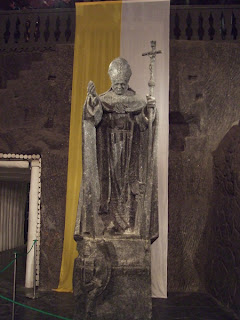The Wieliczka salt mine is indescribably immense. Just huge. And nothing like we have seen before.Which is always good!
Legend has it that when Kinga of Hungary (shown here in her widowed nun phase of later life)
was promised in marriage to Boleslaw Wstydliwy of Poland in the 13th century, she brought with her a Hungarian salt mine as a dowry. Before she left Hungary, she threw her bethrothal ring down the mine and on arrival in Krakow, told the polish miners to start digging.
Rather than dismissing her as crazy, they did so, and came back to the surface clutching both rock salt and Kinga's ring and thus the Wieliczka mine was started.

And as I say, it is humungous.
At the time, salt was more valuable than gold and by the time of King Kazimir in the 14th century, one third of the wealth of his kingdom came from salt production and Krakow and the Wawel castle were built with its profits.
It extends under the entire area of the town and down to nine levels, connected by a series of shafts and tunnels and is apparently the only salt mine in the world that has been in continuous operation since mediaeval times. Although no salt has been mined there since 1996, they still employ mine experts to ensure everything stays stable. In its heyday, the mine was operational 24 hours per day, and employed 2,100 men split into three shifts.
We spent c2.5 hours down in the various tunnels and apparently saw only 1.5% of it. that's how big it is!
You have to visit as part of a guided tour, and having been pre-warned by Meli, we chose the cheaper polish-tour-plus-english-audio-guide option. Which worked out just fine. And so we descended down the 380 steps and into the deep.
Due to the way it was formed, under the bed of the mycean sea, the salt is deposited in both blocks and seams so immense chambers have been hewn out of the rock, supported by wooden piles and connected by wooden pillared tunnels.
And yes, the walls do taste salty - well you do have to check!
Nowadays, the caverns are mostly full of exhibition pieces about the workings of the mine:
the men,


the equipment
and the horses (who spent up to three years underground at a stretch as being lifted and lowered by ropes through the shaft was just too traumatic for them -
and rock salt sculptures - some by original miners and some by more recent artists - which commemorate various things including;
Kinga and the first discovery of salt, the visit to the mine by Nicolas Copernicus,
and the dwarves who apparently appear between shifts to help the miners, and small miners chapels,
salt water lakes - 32% salt, the most saturated water can get -
and, somewhat unexpectedly, a coffee shop, conference hall and exhibition space.
One of the biggest is the glorious Kinga's Chapel.
A vast cavern complete with altar,
rock salt chandeliers,
decorative relief carvings,


and, of course, a dedication to PJP2, who is especially appreciated here for the beatification of Kinga, now the patron saint of salt miners.
Its just amazing.
On reaching the end of the tour, you find the panoramic lift to the top if the tallest cavern, the restaurant and the conference centre, equipped with wifi and mobile access points - all for a price of course...
On Meli's advice, we also waited for the museum tour, a further section of caves with more detailed exhibitions about the geology and mine workings.

Fascinating stuff and well worth the wait for an english tour. It is just a surprise that it isn't better signed and more obvious - we could easily have missed it.
All in all, a great way to spend a day, within easy reach of Krakow (for all you potential minibreakers) and, as tour-of-salt-production-factory, definitely much more interesting and impressive than all those elusive salt pan museums we have so far failed to visit.
And we had guests for dinner last night! As planned, we met Meli, Rafi and Bussli near Auschwitz where they had spent the day and settled into a cosy layby for pasta dinner chez nous and a very fine evening of wine and food and chat was had by all. We even taught them how to play tantrix (a tessallating tile strategy game) much fun!
Honestly, the more we talk to them, the more similarities we find in experiences and approach to van dwelling life - it is like meeting a hitherto unknown tribe from a far off land, and finding they have evolved just the same way you have in complete isolation.... Or something.
They have the same list of 'boy' jobs (driving, engines, fixing things) and 'girl' jobs (food provision, navigation, guidebook reading) as we do and a similar preference for outdoor country places rather than city places.
Rafi has the same shoe problem Will does - or rather, as Will succinctly puts it, Meli has the shoes, Rafi has the problem... And she also has the same 'not enough books on board' problem I do, so we have been able to swap two, which should keep us both happy for a while.
Even their solar shower is broken through over use! (although ours is now fixed thanks to the bathroom sealant which sadly probably won't work on theirs, being a slightly newer design.)
They are headed north today, to Lodz and then on the the coast whilst we are bound for Auschwitz and on to Wroclaw. But we're hopefully going to meet up again in the Great Lakes area before our long trek to the light and frozen north.
Safe travels to all three of you! x x x

























No comments:
Post a Comment